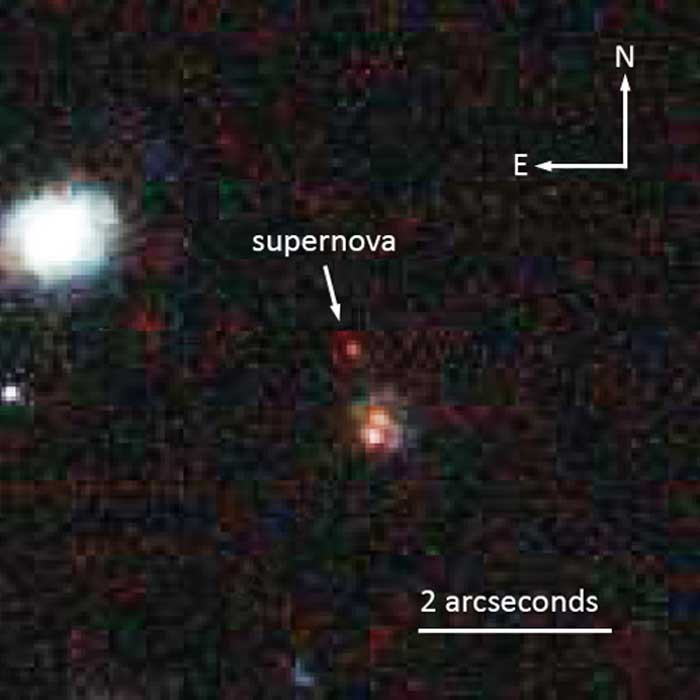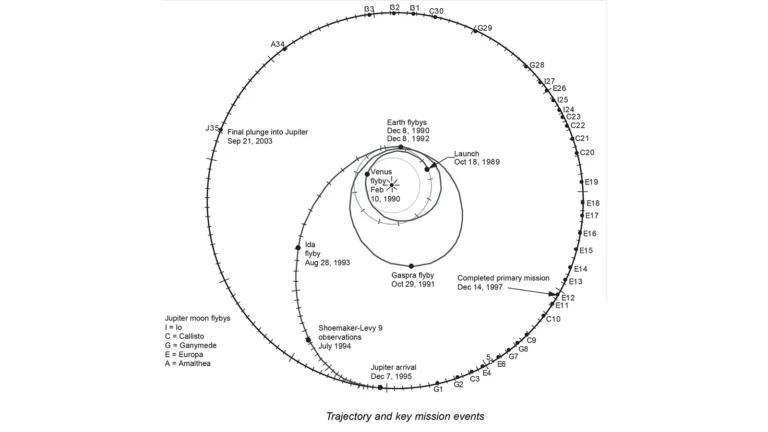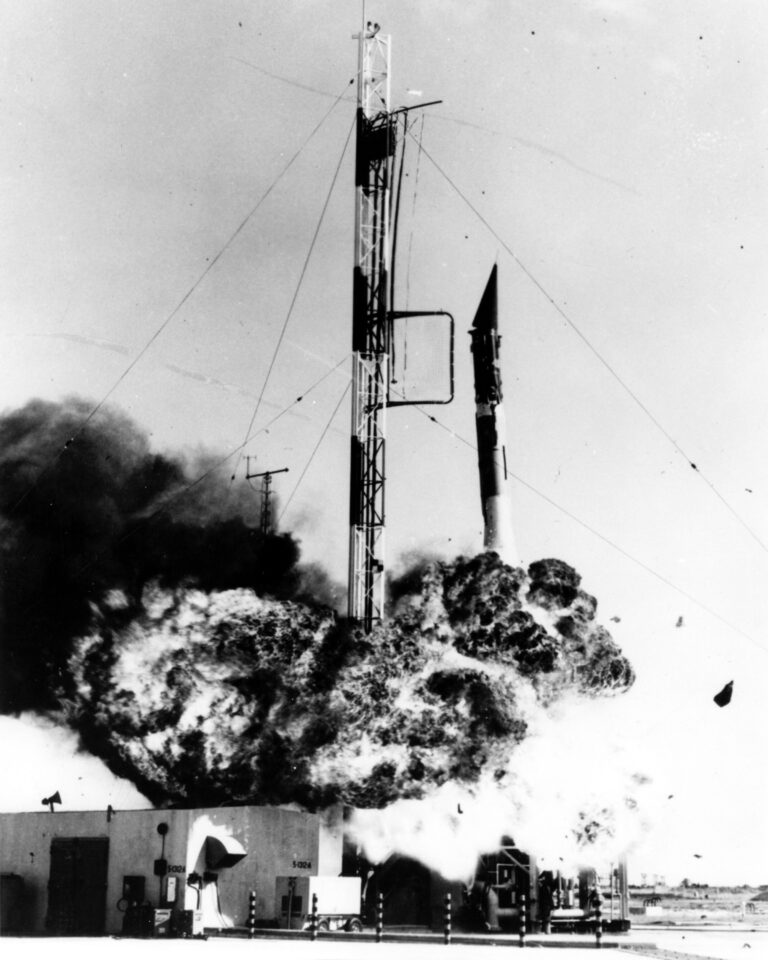Key Takeaways:
“This is the most distant supernova anyone has ever found for doing dependable cosmology,” said Rubin. “The most important unanswered question we have about the nature of dark energy is whether it varies over time — whether it affects the expansion of the universe differently in different eras. With SN SCP-0401, we have the first example of a well-measured supernova sufficiently far away to study the expansion history of the universe from almost 10 billion years ago.”
“Imagine you’re channel surfing, and you come across live news coverage of an exploding star — and then you see the dateline that says it’s July 22, 9,947,989,219 BCE,” said Saul Perlmutter from Berkeley Lab’s Physics Division. “By August 9, the supernova is at its brightest and starts to fade, but you get to watch the whole thing — even though before the news could ever reach your TV our solar system had to form, and then our planet, and intelligent life had to evolve on Earth.”
Live-at-the-scene coverage has special advantages. While the light curves of most supernovae with redshifts above 1.5 are either incomplete or not cosmologically useful because their colors can’t be accurately measured, our imaginary wayback TV broadcast, said Perlmutter, “has enough high-resolution information to allow us to confidently compare this ancient supernova with much more recent astronomical events.”
Most supernovae begin as stars whose cores collapse, but a type Ia supernova, in the simplest model, begins as a white dwarf star borrowing mass from a companion star; when it reaches critical mass, it erupts in a titanic thermonuclear explosion. While not identical, type Ia supernovae are more similar in brightness than any other type, and their variability can be accurately corrected for comparison.
This makes them excellent “standard candles” for measuring cosmic distances — the dimmer they appear, the farther away they are, and their distance can be confidently measured. At the same time, their redshift is a direct gauge of how much the universe has expanded since the supernova exploded.
Measuring the history of expansion ultimately depends on comparing distance and redshift for enough type Ia supernovae over a long expanse of time. This is how accelerating expansion, propelled by dark energy, was independently found by two competing teams and announced in 1998. For this discovery, in 2011 Saul Perlmutter divided the Nobel Prize in physics with Brian Schmidt and Adam Riess of the competing High-z Supernova Search Team.
The new supernova Rubin announced at the AAS meeting was first spotted in a supernova survey conducted by the Supernova Cosmology Project using the Hubble Space Telescope (HST) in 2004, part of a scheduling sequence in which the two teams shared alternate scans of the sky.
“We were looking for supernovae so far away that they really required the HST not just to detect them but so we could separate them from their host galaxies in hopes of getting clean spectra,” said Rob Knop from Quest University Canada. Following an SCP tradition of nicknaming candidates after composers, Knop and colleague Rachel Gibbons, both then at Vanderbilt University, named the new contender “Mingus” after the jazz composer.
A needle in a haystack far, far away
Mingus was so distant that it skirted the edge of invisibility — like trying to see a firefly all the way across the United States. And it was red — possibly its intrinsic color but more likely due to very high redshift. Researchers could tell for sure only with an accurate spectrum.
Initial spectra were captured by the Hubble’s Advanced Camera for Surveys (ACS), equipped with a grism — a combined diffraction grating and prism — that collects light from the target object and from nearby objects, as well.
“The ACS grism data suggested the most likely match was a type Ia supernova at redshift 1.7 — very distant and very old — but by itself the ACS could not establish the spectral features which could confirm this,” said Andrew Fruchter of the Space Telescope Science Institute in Baltimore, Maryland.
The problem was solved when a different grism-equipped camera, the Wide Field Camera 3 (WFC3), was installed on Hubble in 2009. When Rubin saw the data, he realized that the WFC3 had luckily caught some of the spectrum of Mingus’ host galaxy.
“The new WFC3 data pinned down the host’s redshift at 1.713 — a match to the first estimate for Mingus,” said Fruchter. “Each new instrument on HST has enabled new discoveries. It’s exciting to see Hubble continue to make breakthroughs even as we are building its successor.”
To confirm that faraway Mingus really was a type Ia, Rubin derived a spectrum model that allowed him to compare its spectrum with published spectra from other type Ia supernovae, as well as from core-collapse supernovae, as these objects would appear at redshift 1.713. The best-fit type Ia spectrum was an almost perfect match with Mingus’ spectrum. With Rubin’s model indicating an over 90 percent chance of its identity — a conservative estimate — Mingus was confirmed as a type Ia and with confirmation got its more official-sounding designation, SCP-0401.
“To be able to directly compare different type Ia supernovae, we have to fit their light curves — the time it takes the supernova to reach maximum brightness and the time it takes that brightness to fall off,” said Rubin. “We also have to be able to compare the brightness of the different colors during this process in order to calibrate the supernova.”
Perlmutter remarks that such calibration “can be a lot like trying to match a particular shade of house paint when you’ve got a thousand color chips to compare, maybe more.” In this case, calibration meant finding exactly the right shade of red. Both the ACS camera and the Near Infrared Camera and Multi-Object Spectrometer (NICMOS), also carried aboard Hubble, measured SCP-0401’s apparent brightness in different colors over time.
The cosmological picture from SCP-0401, a single distant data point, begins to sharpen astronomers’ measurements of dark energy’s possible time variation. This is the first step toward the precision measurements that will require observations of many more type Ia supernovae as far away as SCP-0401.
“Hubble is our best bet to find and measure similar distant supernovae,” said Rubin. “Luckily, Hubble has a few good years left.”










